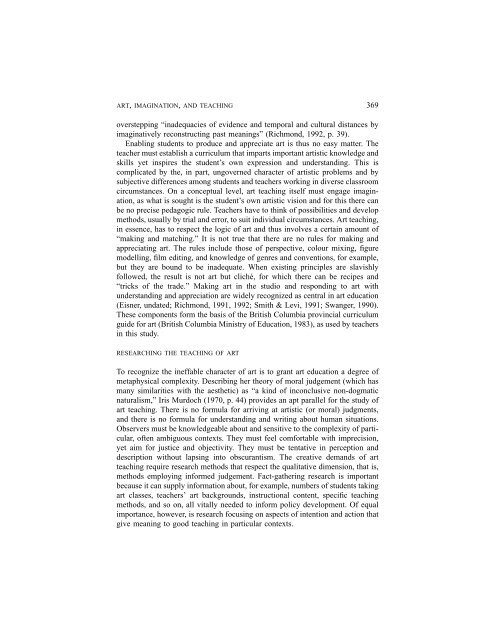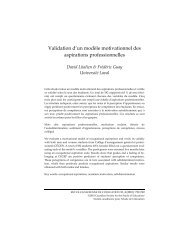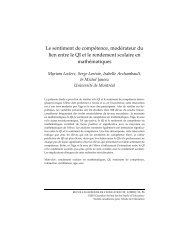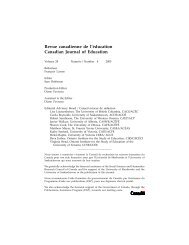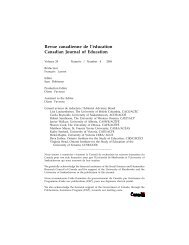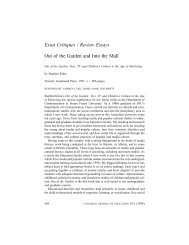Mireille Falardeau et Michel Loranger Le choix de stratégies ... - CSSE
Mireille Falardeau et Michel Loranger Le choix de stratégies ... - CSSE
Mireille Falardeau et Michel Loranger Le choix de stratégies ... - CSSE
Create successful ePaper yourself
Turn your PDF publications into a flip-book with our unique Google optimized e-Paper software.
ART, IMAGINATION, AND TEACHING 369<br />
overstepping “ina<strong>de</strong>quacies of evi<strong>de</strong>nce and temporal and cultural distances by<br />
imaginatively reconstructing past meanings” (Richmond, 1992, p. 39).<br />
Enabling stu<strong>de</strong>nts to produce and appreciate art is thus no easy matter. The<br />
teacher must establish a curriculum that imparts important artistic knowledge and<br />
skills y<strong>et</strong> inspires the stu<strong>de</strong>nt’s own expression and un<strong>de</strong>rstanding. This is<br />
complicated by the, in part, ungoverned character of artistic problems and by<br />
subjective differences among stu<strong>de</strong>nts and teachers working in diverse classroom<br />
circumstances. On a conceptual level, art teaching itself must engage imagination,<br />
as what is sought is the stu<strong>de</strong>nt’s own artistic vision and for this there can<br />
be no precise pedagogic rule. Teachers have to think of possibilities and <strong>de</strong>velop<br />
m<strong>et</strong>hods, usually by trial and error, to suit individual circumstances. Art teaching,<br />
in essence, has to respect the logic of art and thus involves a certain amount of<br />
“making and matching.” It is not true that there are no rules for making and<br />
appreciating art. The rules inclu<strong>de</strong> those of perspective, colour mixing, figure<br />
mo<strong>de</strong>lling, film editing, and knowledge of genres and conventions, for example,<br />
but they are bound to be ina<strong>de</strong>quate. When existing principles are slavishly<br />
followed, the result is not art but cliché, for which there can be recipes and<br />
“tricks of the tra<strong>de</strong>.” Making art in the studio and responding to art with<br />
un<strong>de</strong>rstanding and appreciation are wi<strong>de</strong>ly recognized as central in art education<br />
(Eisner, undated; Richmond, 1991, 1992; Smith & <strong>Le</strong>vi, 1991; Swanger, 1990).<br />
These components form the basis of the British Columbia provincial curriculum<br />
gui<strong>de</strong> for art (British Columbia Ministry of Education, 1983), as used by teachers<br />
in this study.<br />
RESEARCHING THE TEACHING OF ART<br />
To recognize the ineffable character of art is to grant art education a <strong>de</strong>gree of<br />
m<strong>et</strong>aphysical complexity. Describing her theory of moral judgement (which has<br />
many similarities with the aesth<strong>et</strong>ic) as “a kind of inconclusive non-dogmatic<br />
naturalism,” Iris Murdoch (1970, p. 44) provi<strong>de</strong>s an apt parallel for the study of<br />
art teaching. There is no formula for arriving at artistic (or moral) judgments,<br />
and there is no formula for un<strong>de</strong>rstanding and writing about human situations.<br />
Observers must be knowledgeable about and sensitive to the complexity of particular,<br />
often ambiguous contexts. They must feel comfortable with imprecision,<br />
y<strong>et</strong> aim for justice and objectivity. They must be tentative in perception and<br />
<strong>de</strong>scription without lapsing into obscurantism. The creative <strong>de</strong>mands of art<br />
teaching require research m<strong>et</strong>hods that respect the qualitative dimension, that is,<br />
m<strong>et</strong>hods employing informed judgement. Fact-gathering research is important<br />
because it can supply information about, for example, numbers of stu<strong>de</strong>nts taking<br />
art classes, teachers’ art backgrounds, instructional content, specific teaching<br />
m<strong>et</strong>hods, and so on, all vitally nee<strong>de</strong>d to inform policy <strong>de</strong>velopment. Of equal<br />
importance, however, is research focusing on aspects of intention and action that<br />
give meaning to good teaching in particular contexts.


